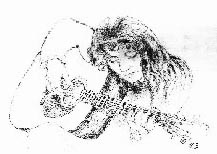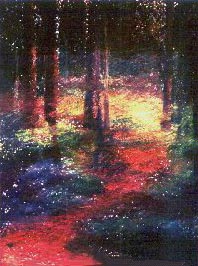|
"Weave for us a garment of brightness: |
|
Bio-Appalachia: ASA 2000
Graphic: Forest Path, watercolor by Vera A. Jones
One theme, echoed recently in more populous areas, was the incursion of “monoculture”
against diverse populations in Appalachia, possibly a holdout because of the mountains
that have held it somewhat remote from previous invasions, and concern for maintaining
its diverse identity. In one forum, Rita and Craig Sutherland of Abingdon Virginia's ABN-FM
shared the triumphs and heartaches of attempting to maintain the work and love of their
lives, a unique independent radio station, in the face of a forceful takeover attempt, fought
through the press and courts, by a regional “conglomerate” that wished to garner its
market popularity and convert its format. Marilou Awiakta, a Cherokee author of years and
distinction, attended and spoke at a forum on her poetic observations and objections to
the more lethal of modern developments. Our inner-joinedness, our connection to the
earth as a primal, life-giving source that requires respect and renewal for survival
on the planet were the subject of several papers, poetic in themselves. Another forum
addressed the dearth of children’s literature, particularly poetry, that will convey to the
youngest generation myths and values that have traditionally sustained cultural heritage,
ethical individualism, and a sense of self. Appalshop, revered for the quality and depth
of its artistic commitment over the years to recording and preserving Appalachia as it
really is for people that live, work, play and create in the region, presented an
award-winning film (“To Save the Land & People,” by Anne Lewis) on the effects of
Kentucky strip-mining on its environment and culture.
There were, in total, 64 forums (presenting 129 papers, 19 roundtable discussions, several films and readings) ranging from "The Sacred in the Land" to "Cocke County Lives and Heritage: Youth Panel & Sample Video," many of them concurrent and all inviting comments
and questions, rounded in the evenings by traditionally Appalachian music and dancing,
fiddles and “calling,” and displays of handmade regional wares, finger harps and
dulcimers most notably. Sessions were stretched over three venues, two hotels and
conference center connected by an arial walkway.
Nearby, Knoxville’s Market Square provided an eerie reminder of change. Nearly all of
the shops were boarded up although the buildings had obviously been remodelled and
repaired from a previous era of architechtural innovation. What once had been a
thoroughfare, for model-T’s perhaps and horse-drawn affairs, had become a
nearly-deserted pedestrian mall with an iron-fenced park, replete with stream and
waterfall, benches and deliberate horticulture. A few men in raggy dress, one barefoot,
wandered comfortably by the boarded-up windows and doors of once-fancy couture
shops and restaurants. Only one, serving remarkable mostly Mexican food and
displaying original art on its walls, still stood against the exodus to suburban malls. A
student from nearby U.T. expressed optimism that the current fate of Market Square was
transitory, that its location of six walking blocks from the university would help to revive
it as a source of urban recall and resurgence.
Also within easy walking distance, the Knoxville Museum of Art (admission $4, plus $3
for a special on-loan exhibit, courtesy of DC's National Gallery of Art, of works by M. C. Escher) displayed on four floors varieties of art from
the region and beyond. A special exhibit by Renee Stout expresses with originality and striking
form the experience, interior and exterior, of an African-American woman encountering
modern life and relationships. Suddenly, classical music and jazz drift from the piazza
level that leads to a gravelled outdoor sculpture garden. A guard smiles and frowns.
What is that? A pony-tailed student is playing, beautifully, the grand piano, raised on its
platform by windows wall to wall. I stand on the balcony, looking down, enjoying the
convergence of mind and hands to music drifting through art. A small crowd gathers in
clumps. Another guard appears and explains curtly that the piano is not for
impromptu playing; the student gets up without protest from his bench to a discordant
hum. I walk away, then turn to thank him. He smiles and we agree. The rules were
well-broken for a brief reverie but perhaps he must go to class and I must drive two hours
back home.
|
Abingdon's ASA 1999 Graphic: Blackbird, pen and ink, Charles Dyer
Graphic: Blackbird, pen and ink, Charles Dyer
The Appalachian Studies Association, established in 1977 by regional scholars, teachers and activists, holds an annual March conference on a rotating basis at sites in Georgia, Kentucky, North Carolina, Tennessee, Virginia and West Virginia "to share work in progress, to foster cooperation between disciplines and to stimulate new work of significance." The 1999 Conference, located in Abingdon, VA's commodious Southwest Virginia Higher Education Center, spanned three days and 72 forums ranging from "Music, Poetry and Place" with readings from Time of My UnWeaving by Laura Leigh Tussey, through "The Struggle for a
Just Place: Race, Ethnicity & White Privilege" chaired by Jill Carson of the Virginia Organizing Project, to "Sustainable Concepts of Folk Culture & Community," including a presentation by Margaret Gregg:
Graphic above: People of the Grid IV, mixed media sculpture by Margaret Gregg AWA 2000, hosted by East Tennessee State University: "Saints at the Table, Sinners at the Bench"
Johnson City's AWA 1999The Appalachian Writers Association held their 1999 Annual Conference July 16-18 at ETSU's D.P. Culp Center, Johnson City, TN. Featuring a keynote address by Cornell's poet, professor, and NC native Robert Morgan, AWA offered forums for and by writers from all media and informal opportunities for lively interchange of experience in the worlds of literature. From poet, novelist and professor Rita Quillen describing her art and new work through Nick Stump's presentation of transitioning from poet and musician to screenplay writer, 17 professionals shared their expertise and vision. Pre-selected and "open mike" readings, a banquet, award presentations, and an authors' reception and book signing highlighted diverse activities offered for participants in this year's conference. AWA is currently redesigning and updating their web presence to create an on-line resource for and by Appalachian writers.
|
 Questions? Comments? Suggestions? Email countryrag@yahoo.com.
Questions? Comments? Suggestions? Email countryrag@yahoo.com.
text and unattributed graphics © Jeannette Harris April, 1996, 2000. All rights reserved.


